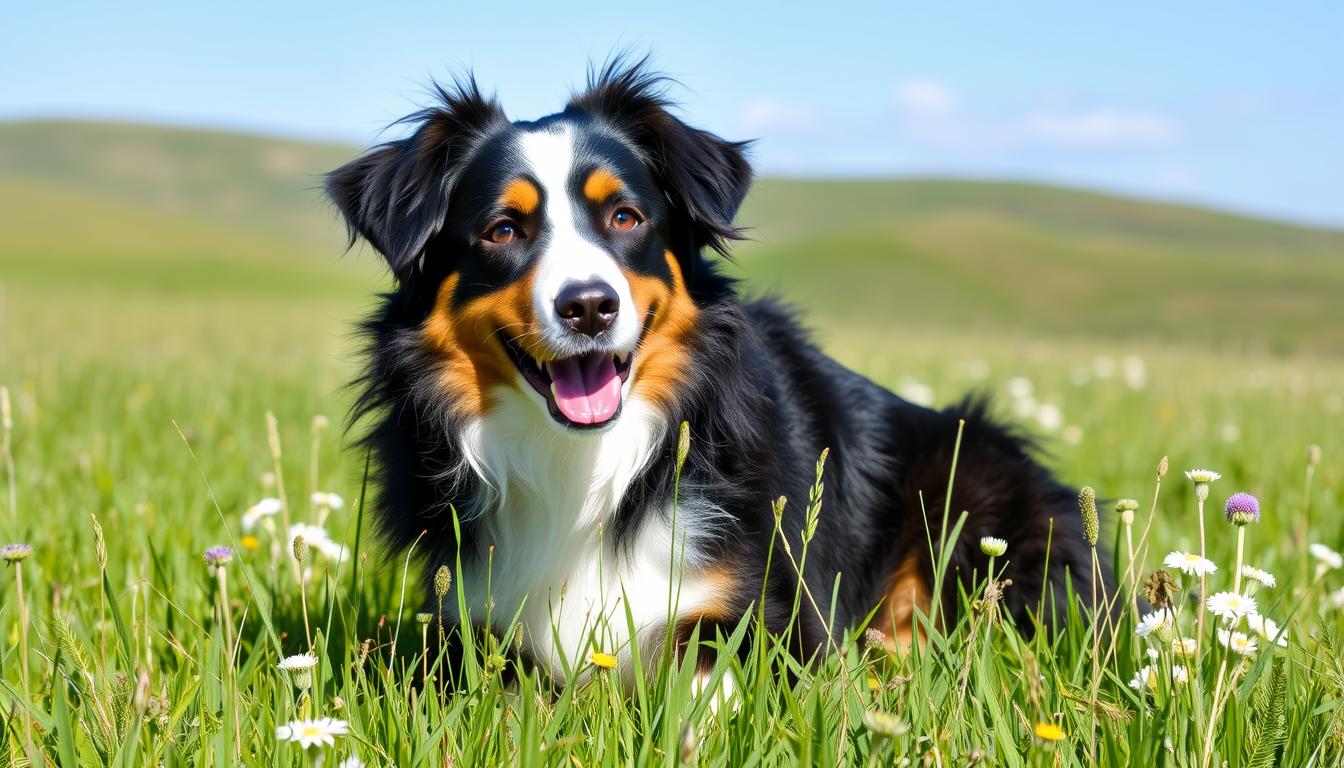The Bernese Australian Shepherd cross is a mix of the Bernese Mountain Dog and the Australian Shepherd. It has the Bernese’s love and the Aussie’s playfulness. This makes it a favorite among families.
This guide will tell you all about this breed. You’ll learn about their traits, temperament, history, grooming, exercise, and health. If you’re thinking of getting one, or just want to know more, this guide has what you need.
Key Takeaways
- The Bernese Australian Shepherd cross typically weighs between 55 and 100 pounds.
- This mix can stand between 20 and 25 inches tall, depending on gender.
- With proper care, their lifespan ranges from 12 to 16 years.
- Common health issues include dysplasia and progressive retinal atrophy (PRA).
- They require consistent grooming, including brushing and dental care.
- The breed benefits from a diet high in protein and healthy fats.
- This hybrid’s temperament includes gentleness from the Bernese and energy from the Australian Shepherd.
Introduction to the Bernese Australian Shepherd Cross
The Bernese Australian Shepherd cross is a special mix of two popular breeds. It’s known for being loyal, smart, and friendly. People love these dogs for their protective nature and how they bond with families.
These dogs need lots of interaction and exercise. They do best with families who can keep them active. Knowing what makes them special is important for those thinking of getting one.

Bernese Aussies have beautiful double coats and can handle different climates. They are both loving and curious, making them great pets. Their unique mix of traits makes them a popular choice for many.
| Characteristics | Bernese Mountain Dog | Australian Shepherd | Bernese Australian Shepherd Cross |
|---|---|---|---|
| Average Height (Adult) | 23–27.5 inches | 18–23 inches | 23–28 inches (Males) 21–26 inches (Females) |
| Average Weight (Adult) | 70–115 pounds | 40–65 pounds | 65–90 pounds (Males) 55–80 pounds (Females) |
| Lifespan | 6–9 years | 12–15 years | Varies, generally healthier with hybrid vigor |
| Exercise Requirements | 30 min – 1 hour per day | 1–2 hours per day | Moderate to high, depending on activity level |
| Grooming Needs | Moderate | Moderate–high | Moderate, inherited from both breeds |
History of the Bernese Australian Shepherd Cross
The history of the bernese australian shepherd cross starts with its parent breeds. The Australian Shepherd was made for herding in the late 1800s. It’s smart and quick, loved by ranchers.
Its breed origins come from British dogs that went to the US and Australia. They mixed skills over many years.
The Bernese Mountain Dog comes from Switzerland. They were strong and loyal, helping farmers and artisans. When farming changed, their numbers fell. But, by the early 1900s, people started to save them again.
Mixing the Australian Shepherd with the Bernese Mountain Dog makes a special dog. The Bernese adds gentleness and the Australian Shepherd brings energy. This mix makes a dog that’s playful yet calm.

Understanding the Parent Breeds
Looking into the traits of the parent breeds helps us know what to expect from the Bernese Australian Shepherd Cross. This mix gets special qualities from both the Bernese Mountain Dog and the Australian Shepherd. These qualities can be very different.
Characteristics of the Bernese Mountain Dog
The Bernese Mountain Dog is known for its gentle demeanor and loyalty. This breed has many traits:
- Temperament: They are calm and loving.
- Protective Nature: They want to keep family and home safe.
- Intelligence: They are smart and love to learn.
- Physical Build: They are big and strong, good for many jobs.
Characteristics of the Australian Shepherd
The Australian Shepherd is loved for its intelligence and lots of energy. Knowing these australian shepherd characteristics is key for owners:
- High Energy: They need lots of play and brain work.
- Intense Work Drive: They do great in herding, agility, and obedience.
- Social and Friendly: They usually get along well with people and pets.
- Vigilance: They are naturally protective but welcome strangers.

The mix of these two parent breeds makes a friendly and versatile crossbreed. They can have different temperaments and energy levels. Knowing each breed’s traits helps me give my Bernese Australian Shepherd Cross a happy life.
Appearance and Size
The Bernese Australian Shepherd cross has a unique dog appearance. It has a thick, medium-length coat in many colors. This includes black, brown, white, and red shades.
This coat is not only beautiful but also needs regular grooming. It keeps the coat healthy and looking good.
Physical Traits of the Bernese Australian Shepherd Cross
This crossbreed has many different physical traits. They can have:
- Long, silky fur for warmth and looks.
- A strong, athletic body from both parents.
- Many coat colors like black, brown, white, and tan.

Expected Size and Weight
Knowing the bernese australian shepherd size is important. Males weigh 70 to 100 pounds. Females weigh 60 to 80 pounds.
Males are 22 to 27 inches tall. Females are 20 to 25 inches tall. Their size means they need lots of exercise.
| Gender | Weight Range | Height Range |
|---|---|---|
| Males | 70 – 100 lbs (31 – 45 kg) | 22 – 27 in (56 – 69 cm) |
| Females | 60 – 80 lbs (26 – 36 kg) | 20 – 25 in (51 – 64 cm) |
The Bernese Australian Shepherd cross is strong and beautiful. They need lots of care because of their size and energy.
Temperament of the Bernese Australian Shepherd Cross
The Bernese Australian Shepherd cross is a mix of traits from its parents. It’s a favorite for those who want family-friendly dogs. They are loyal, smart, and protective. Knowing their temperament helps owners create a happy home.
General Temperament Traits
This dog is loving like a Bernese Mountain Dog and smart like an Australian Shepherd. They are:
- Affective: They love being with family and feeling close.
- Intelligent: They learn fast and want to please.
- Faithful: They protect their family well.
- Playful: They love to play and move around.
- Cautious: They might be shy around new people at first.
How They Interact with Families and Children
They are great for families because of their friendly nature. They love to join in on family fun. They are:
- Gentle Playfulness: They play nicely with kids, enjoying games.
- Protective Nature: They keep their family safe.
- Emotional Support: They know when their family is upset and comfort them.
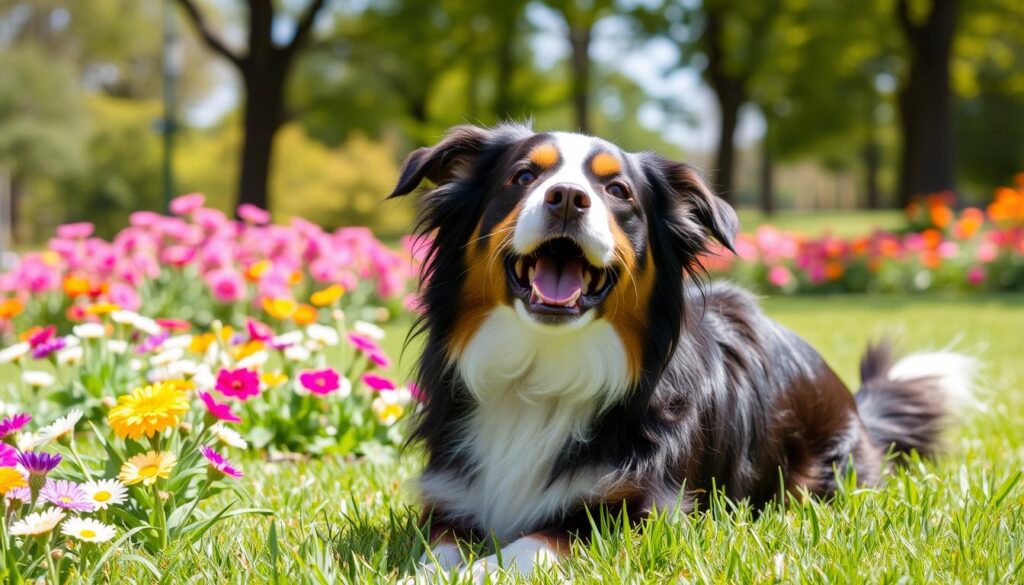
Activity Level and Exercise Requirements
The Bernese Australian Shepherd Cross is very active. They need lots of exercise and mental play. If they don’t get enough, they might get into trouble.
It’s important to keep them busy and happy. This helps them stay healthy and well-behaved.
Importance of Regular Exercise
My Bernese Australian Shepherd Cross needs daily exercise. They love to move and play. This keeps them at a good weight and healthy.
Exercise is good for their body and mind. It lets them be their best selves and live happily with me.
Fun Activities for Your Bernese Australian Shepherd Cross
There are many fun things we can do together. Here are some ideas:
- Hiking: They love going on adventures outside. It’s great for their body and mind.
- Obedience Training: Training is fun and helps them learn good habits. It keeps them sharp.
- Agility Exercises: We can set up a course in our yard. It’s a fun way for them to show off their skills.
- Playdates: Meeting other dogs is fun. It’s a chance for them to play and make friends.
Doing these activities keeps my Bernese Australian Shepherd Cross happy and healthy. They love being active and spending time with me.
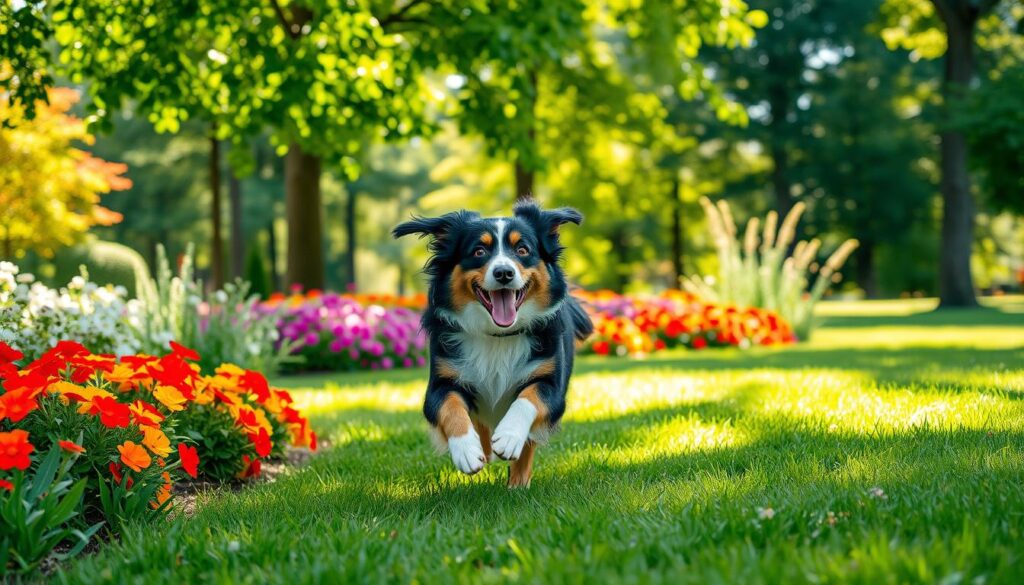
Grooming Needs
Grooming is key to keeping my Bernese Australian Shepherd cross healthy and comfy. Their thick coat needs regular care to avoid mats and stay clean. Knowing how to groom them keeps them looking great and healthy.
Brushing and Bathing
Brushing them often is crucial for their coat. I brush them a few times a week, more in shedding seasons. This keeps their fur smooth and their coat healthy.
Bathing is needed when they get dirty, usually every couple of months. This keeps their coat and skin in top shape without losing important oils.
Seasonal Shedding Concerns
Seasonal shedding is a big deal. In spring and fall, they shed a lot as they change coats. I brush them more during these times to control the hair and keep my home clean.
Knowing when they shed helps me groom them better. This keeps my home tidy and my dog happy.
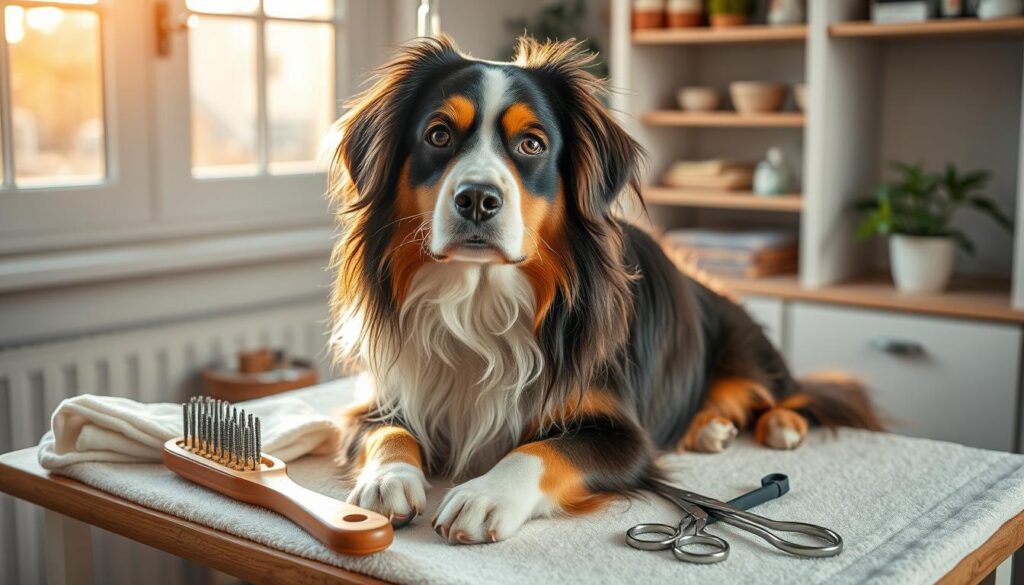
| Grooming Activity | Frequency | Purpose |
|---|---|---|
| Brushing | 2-3 times a week | Remove tangles, distribute oils, and minimize shedding |
| Bathing | Every 1-2 months | Clean coat and skin without removing essential oils |
| Nail trimming | Monthly | Prevent overgrowth and discomfort |
| Ear cleaning | Bi-weekly | Prevent infections and buildup |
Health Considerations for the Bernese Australian Shepherd Cross
My Bernese Australian Shepherd cross’s health is very important to me. They might face certain health problems. It’s key to know about these to care for them well.
Common Health Issues to Watch For
Some common health issues can arise in this crossbreed, including:
- Hip dysplasia – A genetic condition affecting the hip joint, leading to pain and mobility issues.
- Progressive retinal atrophy – A degenerative eye disease that can result in vision loss.
- Bloat – A life-threatening condition where the stomach fills with gas, causing it to twist.
Spotting and treating these issues early can greatly improve my dog’s health.
Regular Veterinary Care and Check-Ups
Regular vet visits are crucial for my Bernese Australian Shepherd cross’s health. These visits help with:
- Routine screenings for health issues, such as hip dysplasia and eye conditions.
- Vaccinations to prevent common diseases.
- Professional advice on nutrition and exercise tailored to my dog’s specific needs.
Regular health care helps catch problems early. It also ensures my dog lives a long and happy life. Spending time and money on vet visits is worth it for my pet’s well-being.
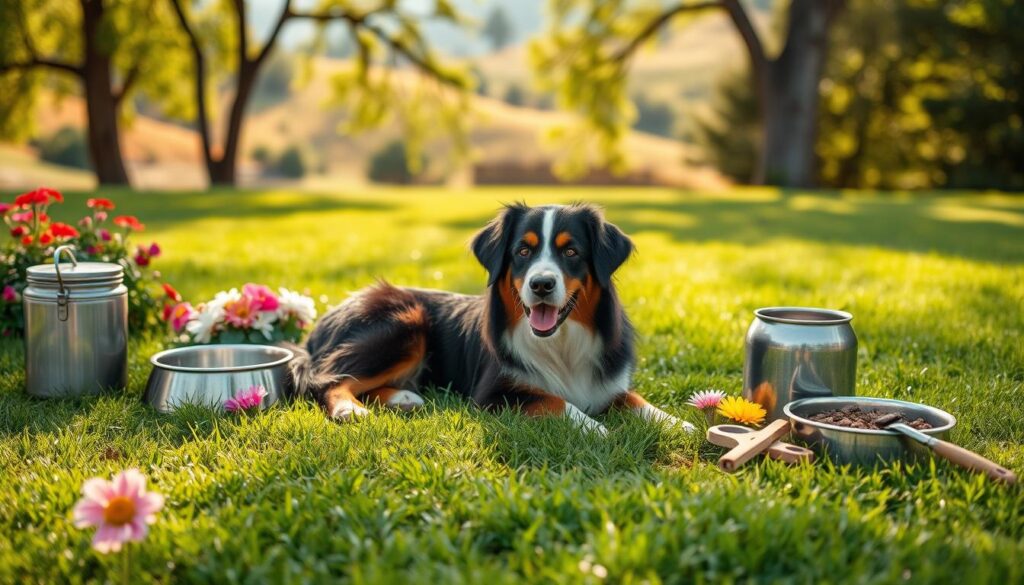
Optimal Nutrition for Your Bernese Australian Shepherd Cross
It’s very important to give your Bernese Australian Shepherd cross the right food. They need a balanced diet to stay healthy and full of energy. Following the right feeding guidelines is key to their happiness and health.
Feeding Guidelines for Healthy Growth
Choosing the right dog food is crucial for their growth. Puppies need food with 26 percent protein and 15 percent fat. This helps them grow without harming their bones.
- Puppies younger than 4 months should be fed four to five times a day.
- Monitor caloric intake based on their size, adjusting as needed for weight management.
- Avoid simple sugars as they can lead to blood sugar imbalances in young dogs.
Recommended Diets and Brands
Choosing top brands can help your dog get the best nutrition. Some great brands for large breeds include:
| Brand | Features |
|---|---|
| Blue Buffalo | Rich in protein and wholesome grains; grain-free options also available. |
| Hill’s Science Diet | Packed with essential vitamins and minerals for overall health. |
| Royal Canin | Formulated specifically for large breeds; focuses on joint support. |

Training Your Bernese Australian Shepherd Cross
Training my Bernese Australian Shepherd cross is key to a happy pet. They need obedience training early on. Using positive methods helps them learn and behave well.
Basic Obedience Training Tips
Start training early for your puppy’s growth. Here are important tips:
- Potty Training: Start on the first day home. Aim for regular potty breaks to avoid messes.
- Basic Commands: By six months, they should know ‘sit’ and ‘down.’ Be patient and consistent.
- Variety: Australian Shepherds get bored with the same thing. Mix up your training to keep them interested.
- Exercise: They need both physical and mental challenges. Daily walks and games are essential.
Socialization Needs for a Well-Adjusted Dog
Socialization is key for a well-adjusted dog. Here’s what I do:
- Exposure: Introduce them to different places, people, and animals early. This builds confidence.
- Positive Experiences: Reward calm behavior around new things. This makes socialization positive.
- Routine: By one year, they should have a daily routine. This includes playdates and classes to improve social skills.
With regular training and socialization, I build a strong bond with my dog. This makes them a loving and well-adjusted pet.

| Age | Training Focus | Socialization Activities |
|---|---|---|
| 8-16 weeks | Potty training, basic commands | Exposure to new sights, sounds, and people |
| 6 months | Reinforce basic commands | Structured playdates with other dogs |
| 1 year | Routine establishment, advanced commands | Regular visits to parks and training classes |
Living Conditions and Environment
Creating the perfect home for my Bernese Australian Shepherd cross is important. I want my dog to be happy and healthy. The right home and outdoor space are key to their happiness.
Best Home Environment for Your Dog
The ideal home for my dog needs space for comfort and fun. Important things to think about include:
- Size of the Living Area: A big indoor space lets my dog move and play. They love to run around.
- Dog-Friendly Decor: Make sure all furniture and decor are safe for pets. Using safe materials is a good idea.
- Activity Areas: Set up special spots for play, training, and rest. This makes the home a happy place for my dog.
Outdoor Space Requirements
Outdoor space is also very important. My dog needs a safe area to play and run. Key things to consider are:
- Secure Fencing: A strong fence keeps my dog safe while they play outside.
- Room to Roam: My dog needs space to run, jump, and explore. This keeps them happy and healthy.
- Dog-Friendly Features: Add things like shaded spots and fun equipment to make outdoor time more fun.

| Living Condition Factor | Recommendation |
|---|---|
| Indoor Space | At least 1,000 square feet for free movement |
| Outdoor Area | Minimum of 300 square feet, securely fenced |
| Play Areas | Open space for active play and exploration |
| Interaction | Family engagement in outdoor activities |
Good living conditions and outdoor spaces make my Bernese Australian Shepherd cross very happy. The right places to live and play are essential for their well-being.
Choosing a Bernese Australian Shepherd Cross Puppy
Getting a Bernese Australian Shepherd cross puppy is a big decision. I need to find a good breeder and check the puppy’s health and mood. This helps me choose the right puppy for my home.
Finding a Reputable Breeder
Finding a good breeder is key. They should care about their dogs’ health and happiness. To find a trustworthy breeder, I can:
- Ask for references from other buyers.
- Visit the breeder’s place to see how the dogs live.
- Ask about health tests for common problems.
- Look for breeders who join dog clubs.
Evaluating the Puppy’s Health and Temperament
Checking the puppy’s health and mood is important. I should look for:
- Physical Health: Look for clear eyes, a shiny coat, and lots of energy.
- Temperament: See how the puppy acts with people and other dogs. It should be friendly and curious.
- Socialization: Check if the puppy has met different places and things.
By doing these things, I can pick a puppy that’s healthy and happy. It will fit well with my family.

| Traits | Details |
|---|---|
| Male Weight | 30 – 40 kg |
| Female Weight | 26 – 36 kg |
| Male Height | 58 – 64 cm |
| Female Height | 52 – 60 cm |
| Coat Type | Long and silky, double coated |
| Coat Color | Combination of white, brown, black, and tan |
| Shedding | Heavy shedding |
| Temperament Traits | Affectionate, Intelligent, Faithful, Loyal, Protective |
Cost and Financial Commitment
Knowing the costs of owning a Bernese Australian Shepherd cross is key. It’s not just the first payment. Many other costs add up over the dog’s life. This part talks about the first costs and the ongoing expenses for these lively dogs.
Initial Adoption or Purchase Costs
Thinking of getting a Bernese Australian Shepherd cross? Be ready for different prices. Prices vary by where you are and the breeder’s reputation. In places like the Northeast and West Coast, prices for Australian Shepherd puppies can be from $800 to $2,500.
Prices are higher for puppies from breeders with champion lines. But, adopting from a rescue can be cheaper. It usually costs between $150 and $500. This first cost is just the beginning of a big investment.
Ongoing Costs for Care and Maintenance
After bringing your pup home, you’ll face ongoing costs. Food and nutrition can cost $40 to $80 a month. This adds up to $5,760 to $14,400 over their life.
Vet care costs about $3,600 to $10,500 over their life. Grooming can add $2,400 to $6,000 if you get it done professionally. Training, toys, and other needs like pet insurance can also add up. Pet insurance costs about $353 to $716 a month.
So, making sure you’re ready for these ongoing costs is crucial. It helps keep your dog happy and healthy.
